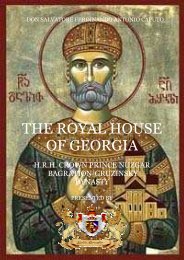here - Nobility Associations
here - Nobility Associations
here - Nobility Associations
You also want an ePaper? Increase the reach of your titles
YUMPU automatically turns print PDFs into web optimized ePapers that Google loves.
THE ANTIOCH HISTORY<br />
Antioch on the Orontes was an ancient<br />
city on the eastern side of the Orontes<br />
River. Its ruins lie near the modern city of<br />
Antakya, Turkey.<br />
Founded near the end of the 4th century<br />
BC by Seleucus I Nicator, one of<br />
Alexander the Great's generals, Antioch's<br />
geographic, military and economic<br />
location, particularly the spice trade, the<br />
Silk Road, the Persian Royal Road,<br />
benefited its occupants, and eventually it<br />
rivaled Alexandria as the chief city of the<br />
Near East and as the main center of<br />
Hellenistic Judaism at the end of the<br />
Second Temple period.<br />
As a result of its longevity and the pivotal<br />
role it played in the emergence of both<br />
Hellenistic Judaism and Early<br />
Christianity, Antioch was called "the cradle of Christianity." It was one of the four<br />
cities of the Syrian tetrapolis. Its residents are known as Antiochenes. Once a great<br />
metropolis of half a million people, it declined to insignificance during the Middle<br />
Ages because of repeated earthquakes, the Crusaders' invasions, and a change in<br />
trade routes following the Mongol conquests, which then no longer passed through<br />
Antioch from the far east.<br />
Antioch was a chief center of early Christianity. The city had a large population of<br />
Jewish origin in a quarter called the Kerateion, and so attracted the earliest<br />
missionaries. Evangelized, among others, by Peter himself, according to the<br />
tradition upon which the Antiochene patriarchate still rests its claim for primacy<br />
and certainly later by Barnabas and Paul during Paul's first missionary journey. Its<br />
converts were the first to be called Christians. This is not to be confused with<br />
Antioch in Pisidia, to which the early missionaries later travelled.<br />
The Christian population was estimated by Chrysostom at about 100,000 people at<br />
the time of Theodosius I. Between 252 and 300, ten assemblies of the church were<br />
held at Antioch and it became the seat of one of the five original patriarchates,<br />
along with Constantinople, Jerusalem, Alexandria, and Rome. Today Antioch<br />
remains the seat of a patriarchate of the Oriental Orthodox churches.<br />
The Hohenstaufen Dynasty - Page 109 of 200



